#zestiria lovemail
Explore tagged Tumblr posts
Text
Okay I can’t say this enough but Sorey as the protagonist really embodies the themes and messages of Zestiria so well that it feels like you can’t truly like Zestiria if you don’t like him. He’s the narrative itself, he might as well be called “Tales of Zestiria” the character.
As an anniversary title, Zestiria puts emphasis on inheriting from your legacy and how to evolve and build on top of that legacy respectfully. From this you can see why the developers would draw inspirations from actual history, and since it’s the Japanese history they’re intimately familiar of, they went with it.
Japanese history has always been highly influenced with spirituality, that’s a fact that Zestiria also tries to bring up. We’ve come so far in these modern times, but that’s also thanks to the many eons of traditions that we’ve exactly come a long way. Think about it, the time we get to live is so short compared to how long the world has lived and will live (yet the world is also still young, it still continues to evolve), recorded in history or not. We’re all connected from the past to the future. If we forget about it and don’t show the gratitude, who will?
I’ve talked about “born Shinto, die Buddhist” but that’s how uniquely pluralistic the Japanese society is. It’s not even moving from one to the other, because both are still practiced, even though people in the modern times often think they don’t have time for things like these anymore.
On one hand, Shinto is really all about how sacred this world is, and that includes your life, so please cherish yourself as well. It is exactly because Sorey, as a mere human who really is not all that special in the larger scheme of things (yet he’s still part of this world, the only one he has), has pure appreciation for the world around him, excitement and curiosity for the mysteries yet to unfold, and the eagerness to pass this feeling onto others that he’s in tune with himself and conscious of the way of the 神. Living in harmony. On the other hand, death is an inevitability of human condition, and Sorey, as the 導師 (a word that also specifically means Buddhist monk for funerals in Japan, as mentioned before), has come to regard death as a way of salvation. Death is often seen as something so sad, so unfortunate, but he has learned that perhaps it can be a release for some. Life is beautiful, life is sacred, but life is also suffering. That is just being human.
This ties in nicely with what he wants to do and what he needs to do. There is passion in both. The things he wants to do, it’s because he knows life has so much more to offer out there, and he has plenty of time and energy for all that! The things he needs to do, it’s because he took upon that responsibility himself, and with that he has to accept viewpoints and approaches he might have had a hard time agreeing with before, but thanks to those his horizons widened and again, death is an inevitability, it must happen. However, both of these don’t exist in vacuum, they’re both interlinked. Both of these are what make a human, human. The more you respect life, the more you respect death. The more you respect death, the more you respect life. A balance is needed here, and in the end, he doesn’t tip the scale too far in one direction, yet he doesn’t lose a sense of himself.
Then you have both Shinto and Buddhism teach you on how to conduct your own self, in relationship to your life, mostly. But you’re not alone, there are others, and they’re different, that should be celebrated! Precisely because there are others that you can shine more in your own way. Each of us has a role to fulfill, and that’s fine, let’s just all work together towards a better future for our successors. In both Shinto and Buddhism, the human is originally pure, yet life makes them be afflicted with either kegare or kleshas. There’s no way around this, that’s just another fact of life as a human, and Sorey accepts this, accepts that malevolence will always be there as long as humans exist, but they don’t and won’t get to define humans, ever. Humans are so much more than the malevolence; humans and malevolence might be inseparable, but they’re barely one and the same. Despite everything, everyone deserves their own chances to come to their own answers.
I don’t know I’m just thinking out loud how much I love Sorey as a character (and subsequently Zestiria as a whole). I’ve been saying this since 2015 but in my eyes he’s one of the most well-executed characters Tales has and I will die on this hill. Not saying it is without its hiccups, but Zestiria is really a thematic masterpiece to me. Everything fits together nicely like puzzle pieces; it starts with this one idea, expands, and then converges again to that one idea.
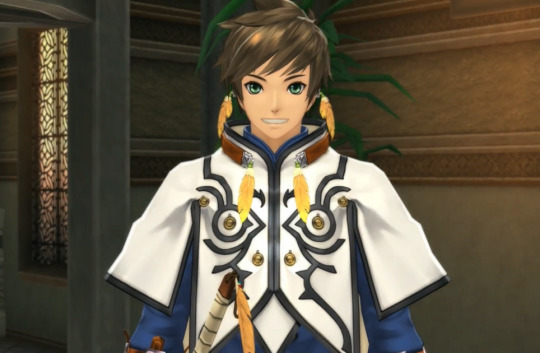
Just look at him. I love him so much I could combust. The legend that has become “hope” to me.
#mino rambles#mino talks zesty#i'm whelmed with FEELS and suddenly all these words pour out#sorey lovemail#zestiria lovemail#i can't stop thinking and overthinking and then falling in love again with this dumb little game#so charming and despite all the wordvomit#words still aren't enough to describe how MUCH i adore tales of zestiria#i really mean this with all my heart and soul without a lick of irony and i've been doing this since january 2015#i will never take my words back#you will find me dead on this hill. or not.#because even if i die i will still through sheer will alone haunt that hill and protect it MY LOVE WILL NEVER DIE#EVER#and you'll be sure of it#i love tales of zestiria#ok shut up mino you've talked TOO much#i will stop here#over my dead body tho#also i said thinking but truthfully i think i'm always head empty i'm incapable of thinking properly#it's all about FEELING i guess to me#there's no overfeeling tho lol#this makes me sound insane but who am i fooling i'm indeed insane
20 notes
·
View notes
Text
Zestiria and Shinto
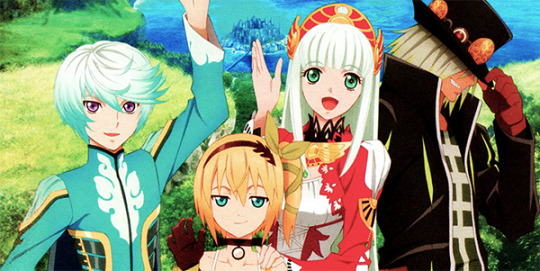
I think it’s very understated that Zestiria takes a lot after Shinto (compared to say, how people keep bringing up its Arthurian inspirations, despite those inspirations being superficial relatively), especially when it’s the essence of the game itself, but I suppose it’s easy for it to go over people’s heads if they don’t truly understand Shinto itself, which to be fair is a concept that is not equivalent at all to the religions widely known in the modern West.
As a preface, if I have to be quite honest, I’m not too fond of the localization of the terms in Zestiria. In isolation, “Shepherd” is a fine translation of “導師”, they both more or less mean a person who guides, though I’m not sure how much of that idea the word manages to get across. However, coupled with “天族” being localized as “seraphim”, the game lore becomes connotated with Biblical implications, which is unnecessary and not at all what is intended, though I’d have been hard pressed myself if I were tasked to localize these terms in a way that could convey the original intent in English, but that’s not the point. The point is, I believe this loss in translation contributes to the misunderstanding, and besides, despite what you might think, the seraphim are not angelic beings, especially of the Christian kind.
With that out of the way, I would also like to clear up something else: religions and religiosity, as defined in the Western culture, do not readily apply to Shinto. It has no single founder, no canonical scriptures that are authoritative like the Bible, it has flexible moral code (or rather, it lacks a rigid moral code) due to its nature, and it is not at all a monolithic system; it’s not a unified system where the people who adhere to the faith proclaim themselves as Shintoists, because it doesn’t work that way. It is literally the “way of the kami” (神道) in that the term is used to reference the practice of worship of kami. It is not at all odd for modern Japanese people to practice this kami-worship and the rituals associated with it while also practicing Buddhism or even Christianity, for example.
The two essential, “sacred” texts of Shinto, Kojiki (古事記, literally “Records of Ancient Matters”) and Nihon Shoki (日本書紀, literally “Chronicles of Japan”), are basically history books (and they were commissioned to be compiled by the government), but they do not encompass everything there is to know about Shinto itself, since there are other books chronicling other kami as well, especially local ones. Even between the two books, mostly because of the differences in intended audience and purpose, there are naturally differences in details and interpretation of the ancient Japanese mythology, some even are contradictory (there are even differences in variants of Shoki accounts of the myth, so let alone Kojiki and Shoki). Also, I say history books (and they for the most part are history books indeed), but it is more apt to say that they are written chronicles of Japanese myths, legends, oral traditions, folklores, and such, but I would say Nihon Shoki is the more “objective” of the two. I think this part inspires Celestial Record as well as Lxi himgnowlot uz Yniitruh (or “The description of Glenwood” in English), the travel notes included as one of the special items in the LalaBit Collector’s Edition of the Japanese version of the game.
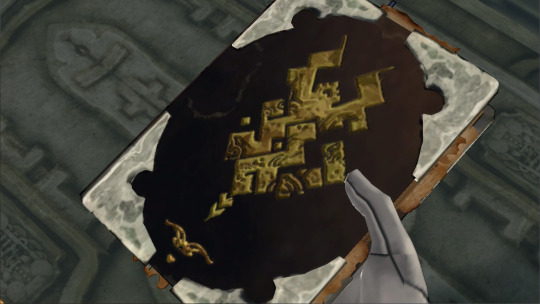
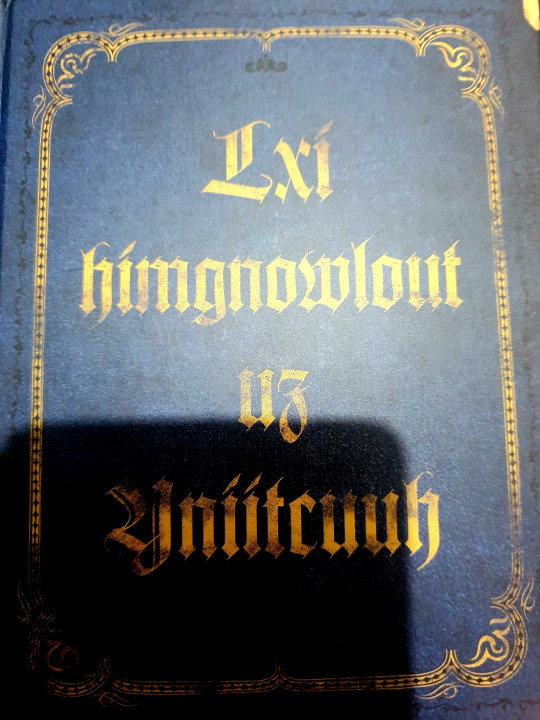
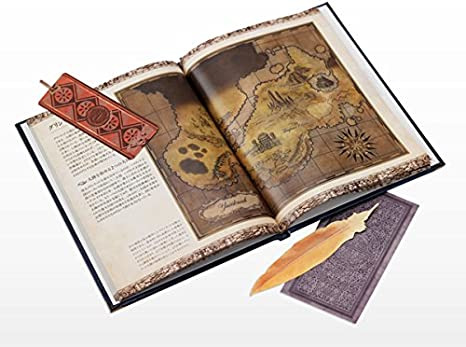
Already you can see how the historiography of Glenwood is influenced by Japanese historiography, because of the belief that has been there all along since the prehistoric times. The subjective interpretations of the situations or even origins that are not immediately knowable, especially, since both of these books are clearly written by humans (that fact isn’t hidden at all), make them feel more like they act as notes of the world, just like Kojiki and Nihon Shoki, and because of this subjective interpretation method, differences are bound to happen, even before getting to the differences of interpretations in individual readers. (By the way, the Japanese name for Celestial Record, 天遺見聞録, clearly implies this too, if translated a bit more literally, it means “the records of what is seen and heard as left behind in the Celestial.”)
Now, we get to the core of this, namely kami (神). Kami is often translated as simply “gods”, but this is, again, very misleading and not at all a good explanation of their nature. Kami, unlike the god(s) in other religions, do not come before or after the cosmos, they are the phenomena themselves and they are ubiquitous. A popular descriptor for them is “spirits or forces of nature” but even this is a simplification of what they really are. Kami describes the mind (心), an underlying principle (基本的原理), the divine to be worshipped (祭る), to be believed in (信じる), to be respected (崇める), to pray to (祈る), to be served (仕える), to be devoted (捧げる), to be given gratitude (感謝する), but most of all, kami possesses an eminent quality that is out of ordinary, that inspires the feeling of awe (畏怖) inside us all. To be in harmony with these awe-inspiring aspects of nature is to be conscious of the way of kami, and all phenomena are candidates for this designation, e.g., the sun, moon, mountains, or even great persons, heroes or leaders. However, to experience the kami presence of any one of these aspects of nature requires a pure and bright heart (清き明き心), which is an emotional, mental, and volitional condition that is not easily attained.
Here, I want to sidetrack to one of the above descriptors, that is, kami are to be worshipped (祭る). If you notice, it is the basic verb form of the word “festival” in Japanese, “祭り”. This is because one of the most crucial deeds toward kami in Japanese view is 祭る. The Japanese tend to be more religious when it comes to ceremonies than to the daily life. Worshipping kami in Japanese sense is different from other religions; whereas for some faith, the worshipping rite seems solemn and preoccupied, on the contrary, many Japanese worshipping ceremonies are very energetic and festive. Though the sacrament can be broken down into two parts: solemn ceremonial ritual and exuberant celebration, only the second part allows many people to participate more. In Zestiria, one of the biggest examples of this is the Sacred Blade Festival (聖剣祭).

But back to kami as beings. They are noble beings to be venerated, and there is a concept of Yaoyorozu no Kami (八百万の神, literally Eight-Million Kami) because there is an infinite number (eight million represents uncountable, just like how 8 as a number is often used to describe “infinity” in many cultures) and it is impossible to know them all (and it’s not like that uncountable number is static either... since humans can turn into kami and kami can inhabit any kind of object, that number naturally expands). Of course, with that many number, kami can vary from one another—they’ve been described as jinkakushin (人格神), or divine beings that have human-like qualities in that they have personalities and emotions of their own. This means that there are both benevolent kami and evil kami, so to speak. They can both bring blessings or harm to humans, and this duality means that kami are both revered and feared. Again, awe-inspiring aspects of nature. Which means Shinto as a religion isn’t exactly concerned with the afterlife like many religions, but with the nature itself, with the current life, as it is our world that is sacred. This is also true for the seraphim and the world in Zestiria.
Another term that is borrowed from Shinto is kegare (穢れ), which I usually translate to “taint” but in the context of localized Zestiria, it is known as malevolence. This, I feel, is another case of the localization causing even more misunderstanding than necessary; the kegare in Zestiria might not map 1:1 to the same concept in Shinto, but they are both fundamentally not a form of moral judgement, and whether the kegare itself is caused by a deliberate act, as for example in the case of a crime, or by an external event, such as illness or death, is secondary. As such, it is wrong to equate it to, say, Christian idea of sin, which malevolence, as a word that inherently suggests evil, kind of conveys to people. Kegare in Shinto is impermanent, as they can be remedied through purification. The concept of purity in Zestiria upholds the same quality being uphold by Shinto, namely, “真” which can be translated as “sincerity” but more literally, it means “truth.” Being true to yourself. This idea is reflected in the aforementioned “pure and bright heart” (“清き明き心”) since “pure and bright” in this case implies something that is transparent, that which is clean and clear, from the kanji themselves (to easily explain this more: 清 means “clear” and the Japanese word for transparent, for example, is 透明, which contains 明).

The Armatus (神依, kamui), as the highest power a Shepherd could have and described as the divine might (神威, which can also be read as kamui), is then, alikened to kamioroshi (神降ろし) in Shinto. Like the name implies (it literally means “descent of kami”), kamioroshi is a divine invocation held in that deity’s honor, to take possession of the one who invokes them. Since seraphim, who are based on kami, are forces of nature beyond mortal understanding, the Armatus again incites both reverence and fear of its powers.
Speaking of the seraphim being said to be beyond what humans could possibly understand, I believe this is partly why the true nature of them isn’t fully revealed. Details like how they’re born (or reborn), how they grow, what they actually are... these are meant to be mythical. We will never know, we can never know for sure. Humans tend to try to make sense of their surroundings, but there are just some things out there that will remain as mysteries to us no matter how much we try to uncover it.
(This applies as well to humans not knowing their own true nature... for example, the true nature of malevolence, said to be an irony of the contradictions of humans.)
――天族について詳しく教えてください。 山本 人から転生したという天族がいたり、いくつかの方則側はあきらかになっていますが、明確にこういう種族だよ、ということはできません。どちらかというと、神霊のような存在となっています。だから、天族たちは自分はこうなんですとか転生したんですと言っていますけど、実は何をどうしたらそうなるかという部分は非常にあいまいだったり、ケースバイケースだったりします。そういう、ルールで割り切れない部分を持った種族ですね。
――Please tell us about the seraphim. YAMAMOTO: There are some seraphim who were reincarnated from humans, and some rules about it have been revealed, but it is not possible to say clearly what kind of race they are. If anything, they are more like divine spirits. That’s why, the seraphim are saying that they are like this or that they are reincarnated, but the truth is, the part about what to do to become like that can be very ambiguous or in a case-by-case basis. They are the kind of race that cannot be comprehended by mere rules.
――天族の成長は自身の思いにかかわってくるのですか? 山本 自分の力の強い時期まで成長するんじゃないかという推測はありますが、ここも実は法則性はないんです。
――Is the growth of seraphim related to their own thoughts? YAMAMOTO: There is a conjecture that they will grow until they reach the peak of their own strength, but again, there are really no strict rules here.
And I understand how and why this would leave some people dissatisfied because they want to fully understand the inner workings of a fictional world to make sense of it, however at the same time, I think it’s not necessary for us to try pin down every detail to understand something holistically. Sometimes it’s fine to just feel it, to leave some things to our imagination even if it might seem hard to make sense of, but part of being humans is to appreciate beauty in these contradictions as well. Not everything has to have [human-knowable] rhyme or reason to it.
(While we’re at this, I would like to express a very subjective, very personal, and admittedly very biased opinion of mine: This is why I wish people would’ve been more appreciative of Zestiria as a standalone separate from Berseria, and not rely on Berseria to fill in the blanks of Zestiria. Berseria, to me, has a very distinct feel from Zestiria in the context of this, as the malakhim of Berseria don’t inspire the awe in me like how the seraphim are depicted in Zestiria. Everything in Zestiria that is supposed to evoke that sense of wonder, like the seraphim, Armatus, etc. is gone in Berseria, which tries to explain everything in a really mechanical, almost scientific way, and that beats the purpose of Zestiria with all its fantastical spirituality and vagueness that a lot of people hate but I personally really adore. And sometimes they can’t even do that right, as a lot of Berseria explanations directly contradict what is shown in Zestiria. This is also why I think intricate, overexplained worldbuilding is overrated; some details are better left hidden, imo. Even hidden is plain sight is better than directly explaining it to us.)
Of course, I can’t adequately explain everything that is inspired by Shinto in Zestiria, and this barely scratches the surface (and that’s not counting inspirations from other myths, religions, and philosophies like Arthurian Legend, Buddhism, Daoism, etc. that are also in the game), but I hope this can give you the rough idea! Zestiria, I feel, is a game that puts a great emphasis on the wonders of its world—it’s not that everything that we know is all there is to the world, and this world has lived for a long time, unimaginably so by humans, so there’s bound to be some things that we just don’t know, we just can’t know, but have been there all along, and you can feel them even if most of the times you can’t put it into definite words. If you think about how vast the world is, and that it keeps evolving in its vast history, some unrecorded... we become more aware and appreciative of how beautiful the world really is. And in the case of Zestiria, this is reflected in the curiosity of Sorey, the protagonist, of the world, along with its history, that opens up before him. The legends have and will always live, and someday they will become “hope.”
#tales of#tales of zestiria#mino rambles#REALLY long post#basically my zestiria lovemail#as a side note: i do think them including arthurian legend inspirations is their way to evoke similar feel to this to western people#what the devs probably don't know is that myths work and feel differently in different parts of the world#so it probably isn't effective in bringing out that sense of wonder#since hase and baba expressed concerns about not wanting zestiria to be TOO japanese#mino talks zesty
100 notes
·
View notes
Text
Water Armatus, Bow and Arrow

I’ve always thought that it is interesting that the Water Armatus wields bow and arrow, especially since it holds many significances in the Japanese culture that Zestiria draws many inspirations from. I believe it’s a deliberate choice that the Divine Artifact needed for Water Armatus is a bow too, so I will try to elaborate more on this, since the many meanings for it might not be apparent to people who aren’t familiar with it.
Remember: Symbols can have more than just one meaning.
First off, and I know we start with the ending part here, but since it’s actually stated in the novel, I will talk about how Mikleo offers to go first, as the whistling arrow (嚆矢). Our first symbolism, but far from the last, for the Water Armatus.
「スレイ、最初に僕を撃ち出せ」
「ミクリオ……!」
息を飲むスレイをミクリオは決意に満ちた瞳で見つめる。 最初に撃ち出す仲間を迷うであろうスレイの気持ちをくみ取った提案だった。
「この旅の終わり、僕が嚆矢となる」
僕たちの決意と覚悟を最初に撃て。
“Sorey, shoot me out first.”
“Mikleo...!”
Mikleo looks at Sorey, who gulped, intently with eyes full of his determination. It was a suggestion that took into consideration the feelings of Sorey, who had been hesitating about which friend he would shoot out first.
“At this journey’s end, I will become the whistling arrow.”
Shoot our determination and resolve first.
The whistling arrow (嚆矢) often symbolizes “dawn” or “beginning”, since it’s used to signal the beginning of battle. Particularly, around the time of Heian period, an arrow with a whistle (kabura, 鏑) attached (so often known as kabura-ya, 鏑矢 as well) would be shot, not only to alert the enemy, but also to ward off evil spirits and alert friendly kami to lend their support through its whistling sound. Befitting for the seraph whose Divine Artifact is a bow, since he does this to reassure Sorey, as well as to ask for support for him from the friendly kami—other seraphim that will come after him. Mikleo is also the one seraph who has been with Sorey since the beginning too, even before Sorey became the Shepherd. Since the dawn of the Shepherd (導師の夜明け).
(An arrow that flies straight and steadfast signifies no hesitation for its resolve.)

But bows and arrows mean so much more than this, so I would like to take a look at other meanings too, as well as going earlier than straight-up the final battle. The first obvious thing that stood out to me is that in Japanese, bow and arrow (弓矢, yumiya) is often a symbol for the battlefield, since 戦 (read as ikusa), meaning war or battle, used to be written as 射交矢 (also read as ikusa), roughly meaning exchanging arrows (射交わす矢). Hachiman (八幡神), the Shinto-Buddhism syncretic divinity of archery and war, is also known as Yumiya Hachiman (弓矢八幡), because his messenger is a dove that symbolizes bow and arrow. Hachiman’s wife, Himegami (比売神), often refers to Munakata Sanjoshin (宗像三女神), the three matriach kami associated with water born from the ukehi or oath (宇気比, 誓約) between Amaterasu and Susanoo (I will talk more about this when I talk about Mikleo’s association with water divinities in Japan, since it can get even more interesting if you dive deep and go down this rabbit hole, and I tend to overthink this kind of stuff anyway).
However, going back to a time even older, the ancient times, bow and arrow used to be written as 箭霊 (read as sachi), with 箭 being the outdated kanji for arrow and 霊 being the kanji for spirits, representing 霊威 or mysterious power. The word 箭霊 (sachi) here has the same reading as 幸 (sachi) meaning happiness, thus bow and arrow are also associated with happiness and blessings. As such, in Japan, where the animism of primitive religion remains strong, the bow and arrow is also a tool for divination of good fortune. In terms of shamanism/sorcery (呪術, jujutsu), often it is also called 天之返矢 (ama-no-kaeshiya, Divine Returning-Arrow), and this word comes from the myth in Kojiki, where a bird named Nakime (鳴女) who was sent down to earth to check in on Amewakahiko (天稚彦 or 天若日子). Amewakahiko shot the bird with his bow. The arrow pierced through the bird, but the arrow flew all the way to heaven. Takamimusubi (高御産巣日神) saw the arrow and threw it back at the earth where it hit Amewakahiko while he was laying in bed, killing him.
There are also Narugen (鳴弦), which is used like a weapon or musical instrument to exorcise invisible demons and evil spirits, and Hama-ya and Hama-yumi (破魔矢・破魔弓), symbols of the bow and arrow’s magical power, as seen in myths and legends.
Hama-ya, in general, has come to mean ceremonial arrow to ward off evil. In Buddhism, there is a legend that the gold bow and arrow held by Umarokya (烏摩勒伽), one of the four yaksha who follow Shoumen Kongou (青面金剛), the blue-faced Vajra, is the origin of the Hama-ya, and Ryuujin Hamaya (龍神破魔矢), the dragon deity, is named after it. The tip of hama-ya needs not to be sharp, since it is used to purify, as to remove the obstacles, not to target and break the person themself.
(I’d like to also remind that the seraphim are based upon Four Symbols, and Mikleo is based on the Azure Dragon. This can even be seen in the Water Armatus’ Banish Blast, 水神・清龍, which can literally be translated to Water Divine: Azure Dragon.)




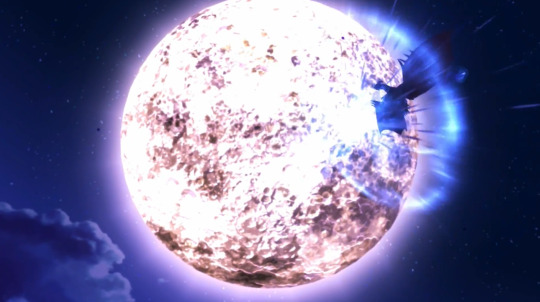
There is this one story, the tale of extermination of Nue (鵺)—a Japanese mythical creature with a monkey’s head, tanuki’s body, tiger’s limbs, and a snake tail—in “Heike Monogatari” (平家物語) where the Emperor was afflicted with an illness, but when Minamoto no Yoshiie (源義家) plucked the bowstring three times, the evil spirit was dispelled and the Emperor was restored to health. However, the source of the disease itself was not dead and continued to threaten the Emperor. Minamoto no Yorimasa (源頼政), then, climbed to the rooftop of the Imperial Palace at night and shot an arrow, and in just that one shot, slaying the source of the disease, a monster called Nue, with Yumiharidzuki (弓張月, representing the bow or the Moon, the crescent moon that looks like a bow).
And thus, the bow and arrow is associated with purification or exorcism (祓い清め) of the mind (心) from taint (穢れ), malice (邪気), evil (魔), and disaster (厄), as seen in a lot of metaphors in Japanese. The pure-hearted is said to be able to immediately hit the bull in one hit. The arrow of the noble is destined to strike the enemy and hunt the beast of fables.
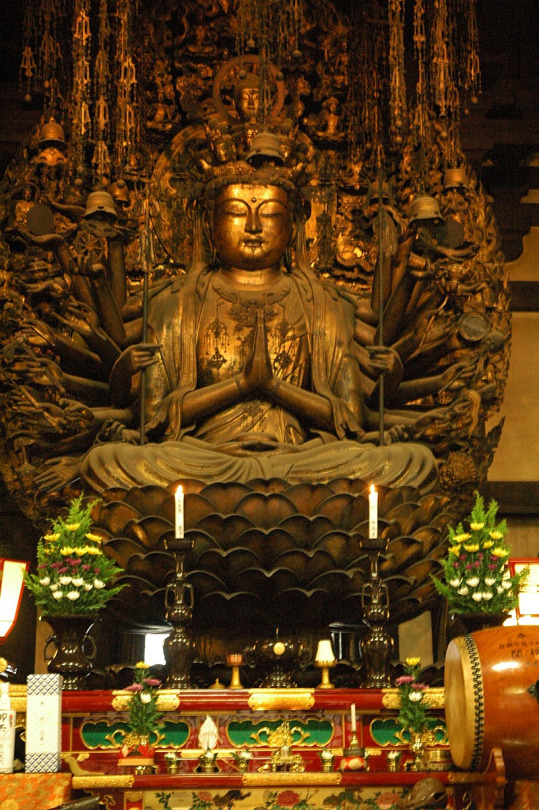
Now we turn to Buddhism. Senju Kannon (千手観音) or Senju-Sengen Kanzeon Bosatsu (千手千眼観世音菩薩), the bodhisattva of compassion and mercy, is perhaps the most widely worshipped bodhisattva in Japan. Senju-Sengen (千手千眼) literally means Thousand Arms and Thousand Eyes, originating from the fact that she has one eye in each palm of a thousand arms. These thousand arms and thousand eyes represent Kannon’s vastness of mercy and the abundance of means to save, as endeavors to relieve every living thing. In her many hands, she holds many objects, and each of these objects varies in meaning.
Two of them are houkyuu (宝弓) and houzen (宝箭), a bow and an arrow, respectively. Houkyuu stands for “increasing the honor” (“栄官を増す”), but more relevant is the meaning of houzen, which is “chance meeting with good friends” (“良き友に巡り会う”). A poetic way of saying reconnecting with true friends.


The final version of Aqua Limit, Aqua Limit: Ultima, is actually called アクアリムス・リ��ニオン, or Aqua Limit: Reunion, in Japanese. This indeed foreshadows their reunion in the epilogue, that they will meet again, and it is by chance (through a connection that ties them, that cannot be seen, yet can be felt, or it is precisely because it’s not seen that it can be felt stronger). Neither knew how long it would take, perhaps it would take centuries, but they could finally get there, reuniting with each other, in the end. Reunion of true friends. Mikleo, the bullet, the whistling arrow, is that connection with true friends that will never fade way, even as he is shot to the risk of his death in the final battle, and after this, Sorey will go to sleep to purify Maotelus for who knows how long. Eons, perhaps.
(Mikleo himself doesn’t consider himself as Sorey’s true friend, since he thinks that as a seraph, he can’t perceive the world the same way as Sorey does. It’s why he invited Rose to join the party. But true friends complement each other, just like how Sorey and Rose have different approaches [sees in different ways], Sorey and Mikleo complement each other through their differences.)
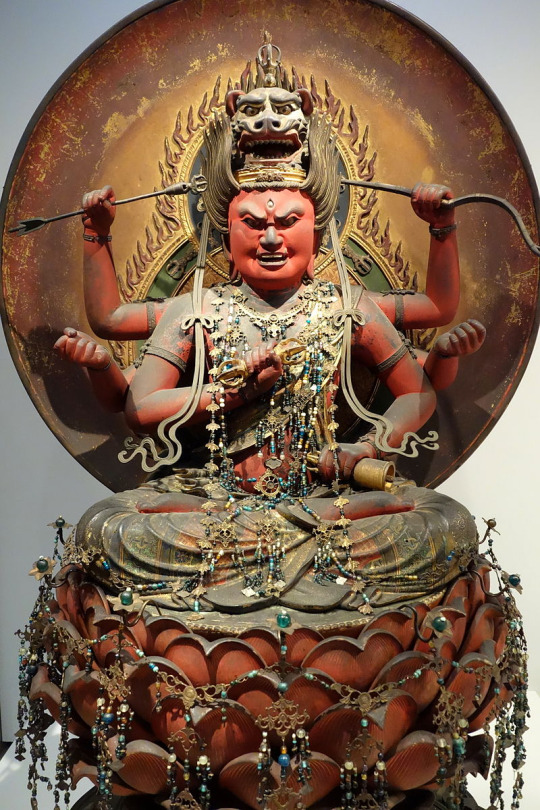
In Buddhism (especially Shingon Buddhism), there is a deity that is often associated with bow and arrow, Aizen Myouou (愛染明王). He has a very distinctive appearance, wearing a shishi (獅子, magical lion)’s crown on his head and sitting on a lotus flower. Sometimes, he is depicted with two heads: of his own and of Fudou Myouou (不動明王, and I believe I’ve talked about Sorey being a Fudou Myouou figure here), symbolizing a commingling of subjugated, complementary energies, and in Japan, they are both enshrined together, Fudou Myouou and Aizen Myouou on the left and right of Dainichi Nyorai (大日如来, I talked about him and his symbolism more in the context of Zestiria here) as the principal object of worship. In Nichiren Buddhism, in the Great Mandala Gohonzon, Fudou Myouou’s bīja “हां” is placed on the right and Aizen Myouou’s bija “हूं” is placed on the left (more on Sorey and Mikleo and Right and Left here and here and here, also while we’re at this, the Left, when paired with the Right, has significance in Shinto here, so there are many layers of meanings to this).

Aizen Myouou is known for transforming worldly desires (kleshas) into spiritual awakening, as seen from his name literally meaning “Love-Stained Wisdom King.” In Nichiren Buddhism, it is said that if Fudou Myouou embodies “life and death (saṃsāra) are precisely nirvana” (生死即涅槃, shouji-soku-nehan), then Aizen Myouou embodies “worldly desires (kleshas) are precisely enlightenment (bodhi)” (煩悩即菩提, bonnou-soku-bodai), which are the two tenets of hongaku (本覚, the innate or original enlightenment). This is because Aizen Myouou doesn’t deny love, and he is indeed known as the Buddha in charge of love, marriage, family harmony; of relationships and connections in general. His name, Aizen (愛染), can also be interpreted as the color(s) aizen (藍染).
I say uniquely Japanese, because the colors are indeed called Japanese blue; depending on how many dips, the shade changes--not just in value but also hue. The lighter it is, the closer it is to blue-green hue. The deeper it is, the closer it is to indigo blue hue.
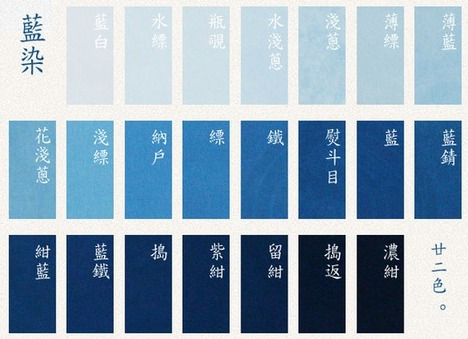
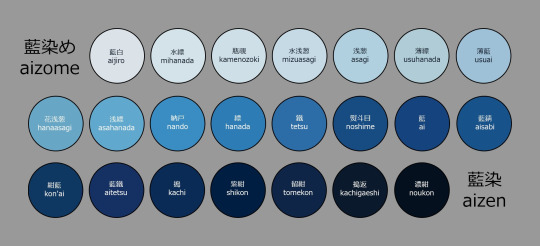
(I also must say that the lighter green-ish blue shade is called 水色 too. Literally the color of water. Commonly translated as aquamarine.)

Like the traditional Japanese blue shades, Sorey's blue is more on the deep indigo blue side in its hue and Mikleo's blue is more on the light aqua blue. Meanwhile, Water Armatus (the two of them) is the "balanced" blue in the middle.

(I have an entire Twitter thread too for this too here)
Finally, I want to talk about a certain saying that also originates from Nichiren Buddhism:

やのはしる事は弓のちから、くものゆくことは・りうのちから、をとこのしわざは・めのちからなり。
The original writing is rather hard to read because it’s written almost entirely in hiragana, but it can be transliterated as follows:
矢の走る事は弓の力、雲の行く事は竜の力、男の仕業は婦の力なり。
Which can be translated to:
It is the power of the bow that determines the flight of the arrow, the might of the dragon that controls the movement of the clouds, and the strength of the wife that guides the actions of a man.
(Remember, again, that Mikleo is connected to dragons/竜, that he is based on Azure Dragon/清龍, and clouds are connected to rain/water and thunder/lightning, two elements associated with Mikleo and Sorey respectively.)
This is from the letter of Nichiren Daishounin (日蓮大聖人). I hope the meaning is obvious enough even without my explanation.
The bow and arrow work in tandem. Without the bow, the arrow cannot work. Without the arrow, the bow cannot work either. It is in the relationship, that even a relationship between a husband and a wife is likened to this.

The same dialogue from the first Water Armatus battle above is repeated again in this scene:


MIKLEO: Sorey, I’ll do the aiming. SOREY: Right. And I’ll pick when to fire.
Despite the Armatization being literally a process of becoming one, of two different physical bodies becoming one, interestingly the human and seraph still retain each of their own consciousness. They don’t blend into one, and the workings of this can be seen in Sorey and Mikleo coordinating to handle the timing and aiming, respectively, when in Water Armatus. Armatus does work in mysterious ways, and it perhaps cannot be described in feelings known to common humans.
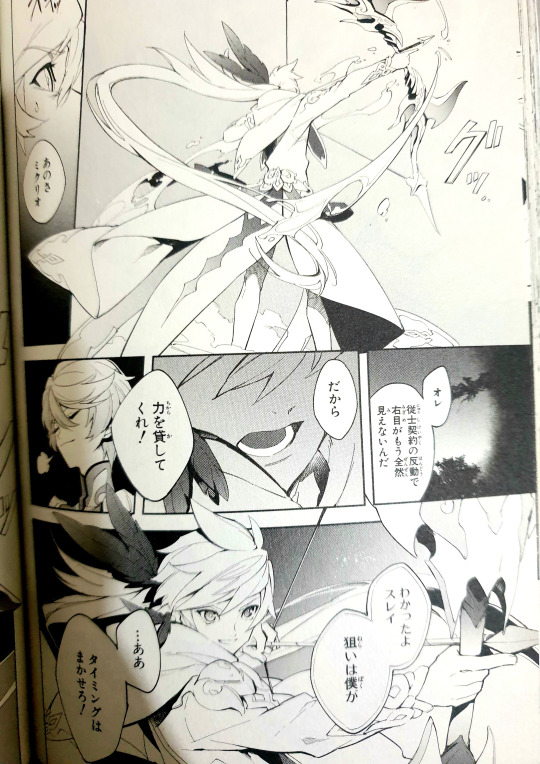
SOREY: By the way, Mikleo. SOREY: Because of the Squire pact, I can’t see out of my right eye anymore. SOREY: So... SOREY: Lend me your power! MIKLEO: Got it, Sorey. I’ll do the aiming. SOREY: Right. And I’ll pick when to fire!
The manga outright makes Mikleo act as Sorey’s eye when aiming at the target, while Sorey handles the timing because of this. This communion, tacit understanding is a major part of their bond, after all, even without the Armatization. The novel also makes it a point that Mikleo offers to do the aiming because he has realized for a long time already that Sorey is blind on his right eye.
異体同心 種族は違うが、同じ想いを抱いて育った。人と天族の可能性を示す。
One Heart in Different Bodies They are of different kinds, but they grew up embracing the same feelings. Showing the possibilities of humans and seraphim.
Exactly because they’re different that they can understand each other, can complement each other, as has been said before. I’ve talked about how Mikleo had needed to learn this, shortly, when I said he didn’t consider himself Sorey’s true friend, but even Sorey needed to learn about this.

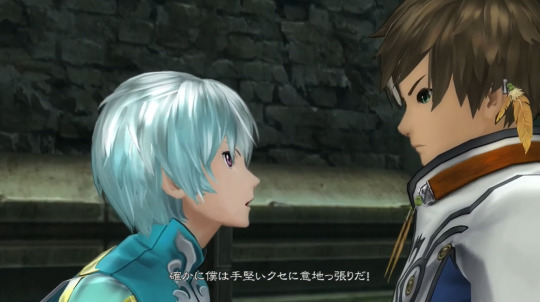




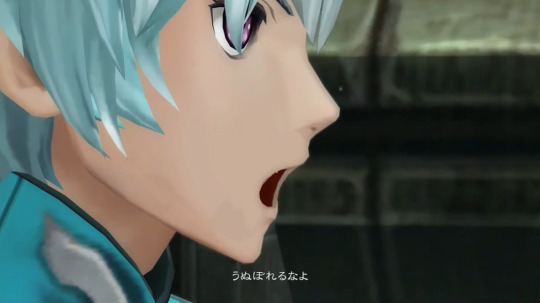

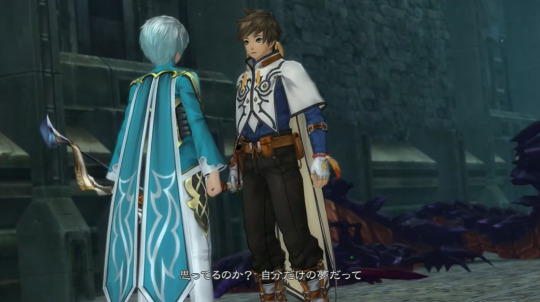



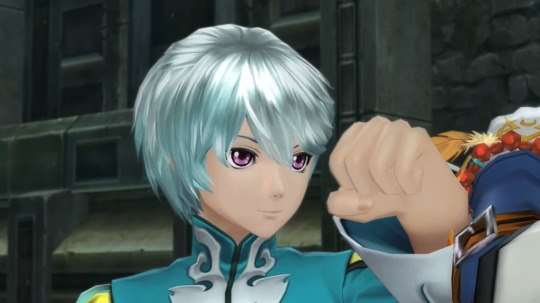
SOREY: Wait, hold on now! MIKLEO: You’re right, I am stubborn as a rock! SOREY: Huh? MIKLEO: I admit it. I’m hell-bent on becoming a Sub Lord. MIKLEO: But there’s something important that you don’t understand! SOREY: I do understand! I just didn’t want you to get involved! MIKLEO: Get over yourself. SOREY: ! MIKLEO: Do you really think this is your dream alone?
SOREY: This is our dream.
Sorey’s flaw in the beginning is that he tends to carry everything by himself, that he doesn’t want the people he cares about to be hurt because of him (or what he thinks as his own responsibility, and not anyone else’s). He was alright with sharing happiness, but afraid to share anything else, even though it was implied that Michael failed as a Shepherd because he carried that burden alone. Even when Sorey and Mikleo fought (because they cared too much about each other), this had already had an effect on Sorey: he didn’t feel the excitement of exploring ruins, he couldn’t see the Earthen Historia, he wasn’t able to de-Armatize at will; and it was only when he accepted Mikleo’s offer to help him, that he could do all these and more (like how Alisha was finally able to hear the seraphim’s voices.)

MIKLEO: I know because it’s you; you were thinking that you didn’t want me to be involved, or that you didn’t want me to carry the burden. MIKLEO: But it’s too late for all that. MIKLEO: Our journey began a long time ago already. MIKLEO: It’s not just your dream. SOREY: ...Yeah. SOREY: This is our dream!
A relationship is balanced if it’s two-way. Their bond is meant to show the limitless possibilities of how a human and seraph can work together to reach their dream together, the dream of coexistence, of being together. To be together is to share not just happiness but also sadness. It’s because life is not lived just by yourself alone, but also with others.

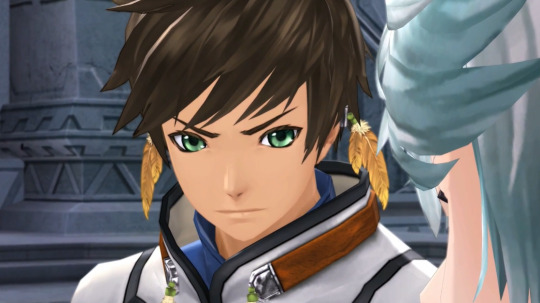
I won’t let you carry this by yourself.
Even until the very end. Just like the power of the bow determines the flight of the arrow, the arrow that flies straight and steadfast without any hesitation for its resolve, warding off anything that is evil, purifying the heart from taint, calling for friendly divinities to aid them. It will reunite them, the true friends, no matter the odds, just bet on that one chance. And this love is not to be denied.
You’ve matured through the course of this journey, and I’m proud of you for that, but don’t forget, I’m also here, right next to you, and I won’t let you carry everything by yourself.
唯一無二の 互いに誰よりも負けたくない相手。だから成長できる。今までも、これからも。
The One and Only They do not want to lose to each other more than anyone else. That’s why they can grow. Until now, and from now on.
Mikleo is the best support Sorey could’ve gotten, even if he didn’t ask for him himself.
May these bow and arrow represent happiness and blessings, just as they used to in the ancient times long past.
弓を構えて真実射抜け
Pull the bow and aim for the truth.
#tales of#tales of zestiria#mino talks zesty#mino rambles#yet another#srmk lovemail#their divine bow is also the most beautiful divine artifact btw at least imo lol#sorey really needed to unlearn his meebogynist views lol#i am now emotional again over all the water armatus moments in the game#i did this to myself and now you all have to experience it too with me
35 notes
·
View notes
Text
Mikleo’s Blessing
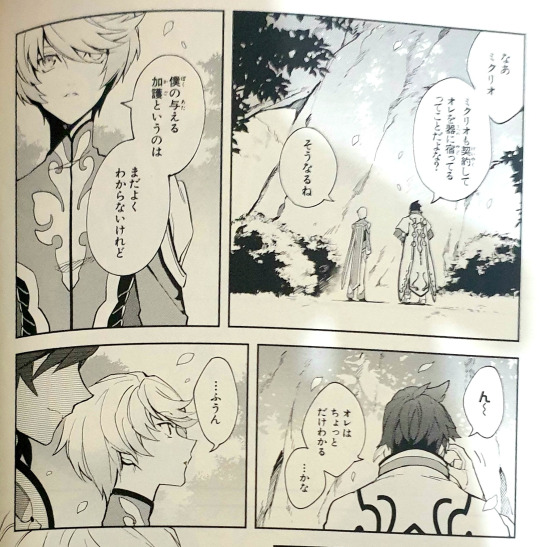
SOREY: Say, Mikleo. You made a pact, so I will be a vessel for you to dwell in, right? MIKLEO: Yeah. MIKLEO: Though I’m still not quite sure what kind of blessing I can grant to you. SOREY: Hm~ SOREY: I have an idea of what it might be... I think. MIKLEO: ...Hmm.
Seraphim are mysterious beings, even they themselves might not truly know the nature of themselves and their powers. What is at least known, is that each seraph can grant their own blessing.
Mikleo, as a young seraph (who might even be considered a baby in terms of seraph years), has always been depicted as someone who knows virtually almost nothing about being a seraph, even perhaps his own blessing. So I will try to surmise his blessing from hints from the game itself as well as supplemental materials (manga, novel, etc.).
Blessings, What They Are
To start, the idea of seraphim’s blessings in Zestiria is modeled after the beings they’re directly inspired by, kami, and the blessings that they grant, which can be seen as both blessing or something that brings upon harm, depending on how you look at it. The way they show how blessings work in the game can be a bit confusing, so let’s look how the official books define it.
First off, the Official World Guidance:
加護
天族は「加護」という形で、人々にさまざまな影響を与える。加護の内容は天族によって異なり、人々にとって必ずしもありがたいものではないこともある。それなら「災厄」と呼ばれるが、本質は同じ。たとえば天族サイモンが加護を与えると、その人物は望む夢を見ることができる。その幻に酔い、現実から逃避する人間もいるだろうが、それを加護ととるか災厄ととるかはその人次第といえる。
Blessings
Seraphim influence humans in various ways in the form of “blessings.” The blessings themselves vary from one seraph to another, and they may not always be appreciated by humans. In that case, they are called “disasters,” but they are essentially the same blessings. For example, if Seraph Symonne gives her blessing to a human, that human can have the dream they desire. Some people may be intoxicated by this illusion and escape from reality, but it is up to the individual to decide whether to take this as a blessing or a disaster.
Then the Perfect Guide:
天族の加護
天族は自然世界の根源に由来する力を持ち、自然現象の一環として創造・産出できる。この働きかけは天族の「加護」として、古くから人々の信心や崇拝の対象となってきた。よく知られているのは五大神信仰にもある「地水火風」の力だが、それ以上にもおよそすべての自然現象、人智の及ばない出来事は、加護によるものと言える。
加護の力と災い
天族の加護は多くの場合、人間にとって恩恵となるが、まれに人を傷つけ追い詰めることもある。風の天族デゼルや幻を操る天族サイモンの加護の資質がそれにあたり、彼らは加護を与えれば与えるほど災いを呼び、いわば人を不幸にする。こうした天族は「疫病神」とも言われ、その存在を人間が感知するかしないかに関わらず、禍事として疎んじられる。
Seraphim’s Blessings
Seraphim possess powers that originate from roots of the natural world, and they can create and produce those powers as a part of natural phenomena. These workings have long been the object of people’s piety and worship as the “blessings” of seraphim. What is well-known is the power of “earth, water, fire, and wind” which is also a part of the Five Lords faith, however, even more than that, almost all natural phenomena and events beyond mortal understanding can be attributed to blessings.
The Power of Blessings and Disasters
Seraphim’s blessings are often a boon to humans, but in rare cases they can also hurt and drive people away. The qualities of the blessings of Dezel, a wind seraph, and Symonne, a seraph that manipulates illusions, are such, that the more blessings they give, the more they bring misfortune, so to speak. These seraphim are also known as “yakubyougami,” and whether humans perceive their presence or not, they are shunned as disasters.
They more or less say the same thing, and the general idea is really the same as the blessings of kami. In the novel, Zaveid also elaborated on what blessings can be like:
「人を不幸にする加護ねぇ。まぁ、そういう天族もいるだろうな」
「そうなのか⁉」
聞いていたミクリオが身を乗り出す。
「まぁ、《加護》っていうからいいもんに聞こえるけど、結局は”人間側から見たら”って話なわけよ。天族の天響術がそれぞれ違うように、《加護》も様々だ。たとえば《植物の育成を助ける》って加護をもつ天族がいた場合、その天族と一緒にいる人間のまわりじゃ、植物が勢いよく育つ。その人間が農作物を作っているなら《恵み》と感じるだろうが、旅人だったらなんの効果もない。もしくは行く先がいつだって草ぼうぼうで《不運》って感じるかもな」
「じゃあ、デゼルの《加護》が不幸を招くっていうのは、どういう作用だったんだろう。サイモンはデゼルの願いが不幸を招いたと言っていたけど……」
「あいつの願いが不幸を招く?なんだそりゃ」
眉をひそめたザビーダに、スレイはサイモンの幻想で見せられたデゼルの過去について話した。聞き終えたザビーダは、頭をがしがしと乱暴にかき、深く息を吐いた。
「これは俺の憶測だが、たぶんデゼルの加護は《旅に恵まれる》だったんじゃねぇかな。風の天族にはそういう《旅》に関する加護を持つやつが多いんだ。デゼルの加護によって《風の傭兵団》の実績はローランス皇室に認められ、定住することになった。するとデゼルの《加護》は傭兵団にとっちゃマイナスの方向へ作用をはじめて、結果、傭兵団は解放。ロゼたちは別の形で旅を始めることになった……。《加護》ってのは、天族が人間と一緒にいたいと思えば、天族本人の意志を離れて発動する。幸せになってほしいと思う相手を不幸にするなら、そいつはたしかに”業”と呼べるかもしれないな」
“A blessing that brings misfortune to people, huh? Well, I guess there are some seraphim like that.”
“Is that so!?”
Mikleo, who was listening, leaned forward.
“Well, blessings sound like a good thing, but in the end, it depends on how the humans see it. Just as the seraphic artes differ from one seraph to another, so do the blessings. For example, if there is a seraph with the blessing to help make plants grow, then plants will grow vigorously around the person who is with that seraph. If the person is a farmer, they may feel it is a blessing, but if he is a traveler, it might as well have no effect. If anything, perhaps they’ll feel unlucky because there’s always grass wherever you go.”
“So how did Dezel’s blessing work to bring upon misfortune? Symonne did say that Dezel’s wish brought upon misfortune....”
“His wish bringing on misfortune? What the hell is that?”
To Zaveid, who raised his eyebrows, Sorey told him about Dezel’s past, as shown to him in Symonne’s illusion. When Zaveid finished listening, he scratched his head and deeply exhaled.
“This is just my guess, but maybe Dezel’s blessing is ‘good fortune for travelling.’ Many wind seraphim have such travel-related blessings after all. The achievements of the Windriders, thanks to Dezel’s blessing, were recognized by the Rolance royal family, and they settled in. Then Dezel’s blessing began to have a negative effect on the Windriders, and as a result, they were released. So Rose and her group started travelling again in a different way.... When a seraph wants to be with a human, their blessing will activate against their own will. If you want someone to be happy yet you bring misfortune to them, I guess you can call it ‘karma’.”
As well as an extra information:
「ザビーダ、よくわかるな」
驚くミクリオにザビーダは片目をつぶってみせた。
「長く生きてりゃ、いろんな奴と出会うからな。そういうのも自然とわかるようになる。……にしても、昔は《加護》の知識も当たり前だったんだがな、人と天族にこれだけ距離ができた今となっちゃ、埋もれた真実になっちまったか」
長命の天族が少し遠い目をして呟いた一言が、スレイの胸にずしりと刻まれる。
“Zaveid, you know a lot.”
Zaveid closed one of his eyes to the surprised Mikleo.
“If you live long enough, you will meet all kinds of people. And you will naturally know those things... even then, in the past, knowledge of ‘blessing’ used to be commonplace, but now that there’s such a distance between humans and seraphim, it’s become a buried truth.”
The long-lived seraph muttered those few words with a slightly distant look in his eyes, and those words were engraved in Sorey’s heart with a heavy thud.
So a relatively really young seraph like Mikleo naturally wouldn’t know about the details of blessings, since on top of everything, the only human he’d only known in life up until recently was Sorey anyway. Of course he never really cared about those when he thought he had no need of it, as someone living only among seraphim in Elysia, with practically no humans to give his blessing to.
(Or is there one...?)
To summarize:
Depending on the human who feels it, blessings can be a good thing, or be seen as misfortune. It’s on the human, which means the human is the one more likely to perceive [sense] it too, if they are conscious of it. Someone with a high resonance and pure heart like Sorey is sensitive to seraphim, so it’s very likely he can recognize it too, even if Mikleo is not aware of his own blessing.
Blessings vary from one seraph to another, but they seem to be related to their element (Dezel) and powers (Symonne).
Knowledge of it used to be commonplace but not anymore, presumably because of the distance that grew between humans and seraphim, there was no need for either to really know about each other, let alone blessings.
The more a seraph wants to be with a human, the more their blessing activates without the seraph’s control.
Almost all natural phenomena and events beyond mortal understanding can be attributed to blessings. Very important here.
Sorey, Heldalf’s Biological, Illegitimate Son
I know, I know, this theory is controversial... and a lot of people seem to consider this to be canon to manga only, however, what people don’t know is that the manga (along with the novel) was directly supervised by Hase, the director of the game and the lead creative, and Yamamoto, the head writer of the game. Shiramine even said that under such supervision, she rearranged the story, so that Zestiria could be enjoyed from another angle, and that every panel, every word was carefully chosen to tell this other version of Zestiria, because it would’ve been boring if it was telling the same story as the game, she thought, as an adaptation.
And I’m inclined to believe her words, since she seemed to be aware of stuff that a lot of official Tales stuff didn’t seem to be aware of. For example, if you pay attention to the positioning of Sorey and Mikleo in the manga, she seemed to be aware that Sorey is the Right (the human, the physical, the body) and Mikleo is the Left (the seraph, the spiritual, the heart) to each other, which a lot of other stuff got wrong, including TOZX. This is the kind of stuff that she would be conscious of if she knew about it, which she did.
Besides, I think the hints were in the game all along. Hase, the game director, told us directly to read between the lines, because everything is there for a purpose in Zestiria, so he’d be happy if we read too much into it. It might not be spelled outright, but there’s a reason why some things are inserted here and there. I think piecing Zestiria together through various media is also his way to have something for the fans to come to their own conclusion, to their own answer, on what Zestiria is really about.
With that in mind...
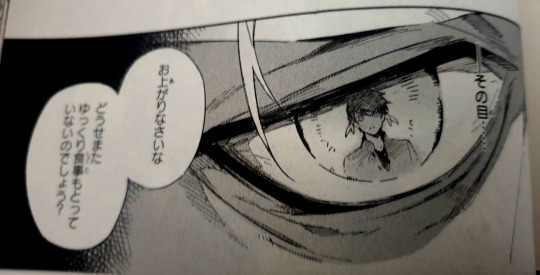
HELDALF: (Those eyes...) SELENE: Please get your head up. SELENE: You haven’t been eating properly again anyway, have you?
Selene said “again”, implying this is not the first nor second time she met up with him. That’s not even addressing the elephant in the room, in that Heldalf finally remembered about Selene, suddenly, when he saw Sorey [when Sorey is finally reflected in his eye].

SELENE: If you walk around with such a tired look on your face, everyone in the village will feel down too. HELDALF: Do you not despair the reality of this invasion? SELENE: I will not despair. HELDALF: (Why do I remember this now...?) SELENE: If we despair... what will guide the children who are born in this village and will eventually leave it? HELDALF: (That which shone alone in the darkness....) SELENE: As long as we do not give up hope, the future will be nurtured there. HELDALF: (That figure....)
There’s a lot to unpack here, but the biggest giveaway is that Selene touched her pregnant belly, wearing what seems to be maternity clothes, talking about the future of the children. Theirs too, perhaps.

HELDALF: (Selene...)
She was really the last thing he remembered before his last breath, and why is that, especially if she was not an important person to him? (By the by, we’ll get into this later, but Heldalf is said to be a family-loving person.)
For the part where I say the game also has hints for this, I’d like to bring your attention to this skit, where the trio talked about Heldalf’s portrait:
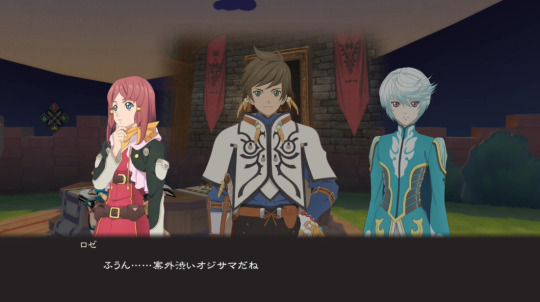


ロゼ「ふうん……案外渋いオジサマだね」 スレイ「うん。オレたちの父親くらいの年齢かな」 ミクリオ「二十年以上前の時点で、ね」
ROSE: Hm. Makes him look like a pretty distinguished gentleman, actually. SOREY: Yeah. He looks maybe the same age as our dads, don’t you think? MIKLEO: Or at least, that's how old he was 20-ish years ago.
Again, deliberate wording. When wondering about his age, Sorey told Rose that he looked like he could be their fathers’ age, to which Mikleo brought up “around 20 years ago”, give or take a few years.
More than 20 years ago was when Michael stopped being the Shepherd and founded Camlann Village, then 17 years ago was when the Age of Chaos began. But 17 is a specific number, and no one talked that specifically, so 20 years is a close approximate.
Which brings us to the beginning of it all.
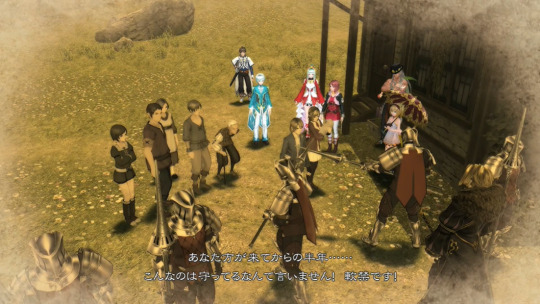
ミューズ「あなた方が来てからの半年……こんなのは守ってるなんて言いません! 軟禁です!」
MUSE: You have occupied our village for half a year now! This isn’t protection... It’s house arrest!
Keep this in mind: the Rolance army had been around in the village for about half a year. The army was hostile against the villagers, despite claiming to protect them. Muse was already holding a baby.
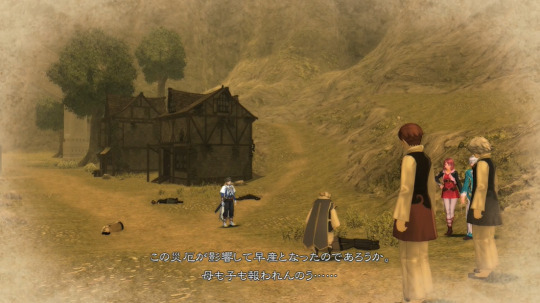

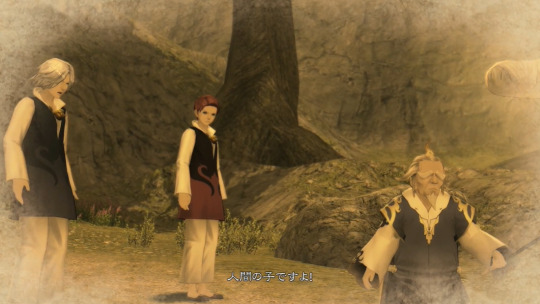
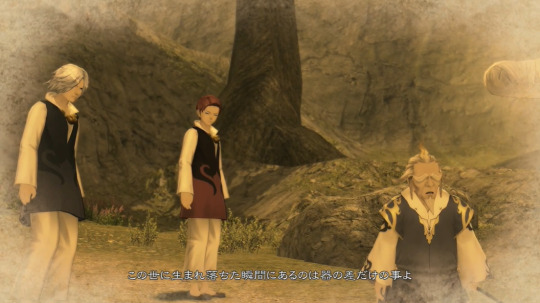


ゼンライ「この災厄が影響して早産となったのであろうか。母も子も報われんのう……」 ゼンライ「……これも縁か」 渋る天族「人間の子ですよ!」 ゼンライ「この世に生まれ落ちた瞬間にあるのは器の差だけの事よ」 マイセン「ですが、これほどの未熟児……持って数ヶ月では……」 ゼンライ「 ……かもしれんのう」
ZENRUS: Born far too early, by the looks of it. Poor mother and child... Neither of you deserved this. ZENRUS: Perhaps this too is fate... RELUCTANT SERAPH: That child’s a human! ZENRUS: Are we not all the same when we first breathe this air, save for the vessel we chance into? MASON: But a child born so premature won't last but a few months. ZENRUS: Probably so.
Sorey, the human baby, was noted to be born prematurely. I’d also like to note that this sentence, この災厄が影響して早産となったのであろうか, directly attributed his premature birth to “this calamity” right after the scene in which Heldalf was cursed to be a hellion, the beginning of him becoming the Lord of Calamity. This will be relevant later on.
だが不意にゼンライは足を止めた。炎の音以外に、かすかだが別の音が聞こえたのだ。見遺れば、息絶えた女が胸の中に守るようにして赤子を抱いていた。災厄が影響して早産となったのだろう。赤子は生後間もない未熟児であった。泣く気力もないようだったが、それでも生きようと微かな呼吸を繰り返している。
「これも縁か……」
ゼンライは愛用のキセルの先を赤子へと向けた。すると、赤子を包むように小さな加護領域が展開され、ふわりと浮かび上がる。小さな加護領域は宙に浮かんだまま、ゆりかごのように揺れ、赤子を守った。
「ゼンライ様⁉ まさか、人間の子を助けるのですか⁉」
「この世に生まれ落ちた瞬間にあるのは、器の差だけの事よ」
渋る天族にゼンライは微笑み、さらに先へ進もうとしたときだ。
However, Zenrus suddenly stopped in his tracks. Besides the sound of flames, another sound was heard, albeit faint. When he looked over, he saw a woman who had died and was holding a baby in her arms, as if to protect it in her chest. Born far too early, must have been because of the calamity. The baby was premature. He seemed to have no energy to cry, yet he was still breathing faintly, trying to live.
“Perhaps this too is fate....”
Zenrus pointed the tip of his beloved pipe at the baby. Then, a small domain of blessing unfolded and floated gently, as if encompassing the baby. The small domain of blessing remained suspended in the air, swaying like a cradle, protecting the baby.
“Lord Zenrus!? Don’t tell me we’re going to save a human child!?”
“Are we not all the same when we first breathe this air, save for the vessel we chance into?”
Zenrus smiled at the reluctant seraph, about to move on ahead.
The novel went about the event almost the same way but confirmed that Zenrus used a domain of blessing to protect the baby.
Then Muse appeared right before Zenrus.
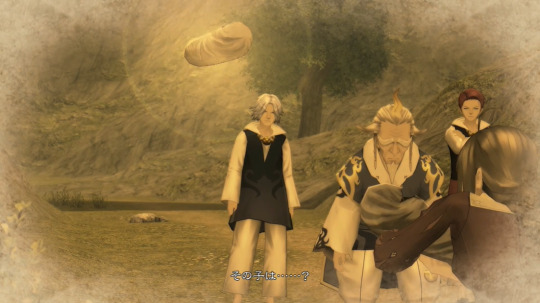
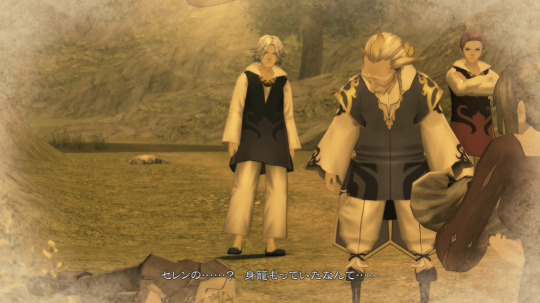
ミューズ「その子は……?」 ミューズ「セレンの……? 身籠もっていたなんて…… 」
MUSE: Who’s that child? MUSE: Selene’s? Could it be she... She was with child?
Despite seemingly knowing Selene (and Camlann was said to be Michael’s family, which had to mean that they were at least a tight-knit community, especially since the village hid a secret that Maotelus was moved there), Muse wasn’t even aware Selene was pregnant. It’d make sense for Selene to try and hide her pregnancy if she had a baby with the leader of an army that was hostile against the villagers, lest she be seen as a traitor of sorts. Not to mention the fact that the baby was premature, and since the army had only been in the village for half a year, it’d still fit the timeline. Again, every line, every word is deliberate.
No changes for this in the novel. The manga went a bit differently, but conveyed the same idea.
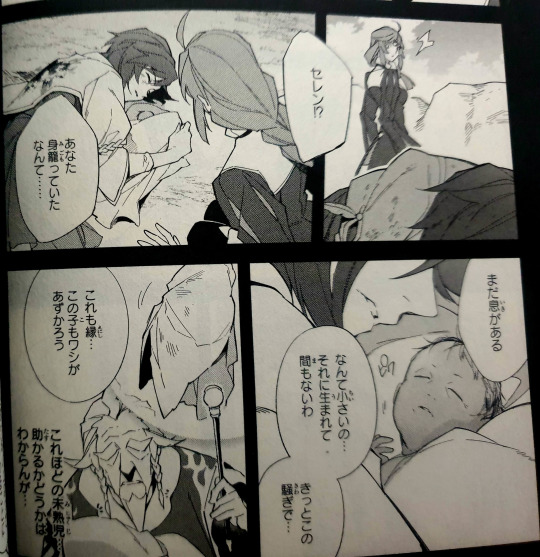
MUSE: Selene!? MUSE: Could it be... you were with a child...? MUSE: He’s still breathing MUSE: He’s so tiny... he wasn’t ready to be born yet. It must have been due to all the stress... ZENRUS: Perhaps this too is fate... I will take care of this child too. ZENRUS: (Though, premature as he is, if he will survive....)
Of note: pregnancy that was not known to Muse, and Sorey’s premature birth.
This illustration for the manga countdown also gives us an idea that Muse and Selene were at least close:

Why is this all relevant? A passage on the Curse of Eternal Solitude should explain this (as seen in one of the Earthen Historia):
孤独の呪いは、彼の唯一の救いであった家族にも牙をむく。両親は病死し、二人の弟が戦で命を落とす。息子のひとりは火事で死亡し、別の息子と娘は首を吊って自殺した。さらに妻と幼い子ども3人が、馬車に轢かれて他界。12人の家族のうち、11人を短い期間で失ってしまった。悲しみに暮れるヘルダルフに残された希望は側室と、彼女がその身に宿した子どもだけだった。
唯一の希望だった、ヘルダルフと側室のあいだに生まれた新たな命。しかし、孤独の呪いから逃れることはできない。生まれた赤子は人間ではなく、醜い鬼子だったのだ。あまりの衝撃に、ヘルダルフは自ら赤子の命を奪う。
The curse of solitude also bared its fangs on his family, which had been his sole salvation. His parents died of illness and his two younger brothers fell in war. One of his sons died in the fire, another son and a daughter committed suicide by hanging themselves. In addition, his wife and three young children passed away after being run by a horse wagon, leaving him to lose 11 of his 12 family members in a short period of time. The only hope left for Heldalf, who was lost in grief, was his concubine and the child she bore in her womb.
That was his only hope, the new life born between Heldalf and his concubine. However, there was no escaping the curse of solitude. The baby that was born was not a human, but an ugly demon child. To his great shock, Heldalf took the baby’s life himself.
The Curse of Eternal Solitude did not only turn Heldalf into a hellion unkillable by regular means, but also seemed to kill the people close and precious to him, which are his family. This family is not only his lawful one, since even his concubine and the baby from that concubine were affected by the curse as well, which meant it should’ve affected Selene and Sorey if she had a relationship with him and he was blood-related to him. And sure enough, Selene died, and her death always was seen after the scene where Heldalf was cursed, whether in the game, novel, or manga. However, for Sorey, Zenrus saved him in time before even the curse took effect (the curse seems to not take effect immediately, but it still managed to kill most of Heldalf’s family in a short amount of time), as he enveloped him in his domain of blessing, even though he wasn’t sure if Sorey would survive anyway in that state (he did, thankfully).
Sorey himself was aware that Zenrus was the one who saved him from “the brink of death” (Taizen page):
高い空の下で、ジイジは世界だった。
戦火に斃れた母から月足らずで生れ落ち、灼けた地面に投げ出されたまま、死の淵にあった自分を救ってくれた人。
Under the tall sky, Gramps was my whole world.
The one who saved me from the brink of death, as I was born less than a month after my mother died in a war and left me on the scorched ground.
Mikleo, the Healer and Protector
So then, where does Mikleo fit into all of this? When it was Zenrus anyway who saved Sorey? I would like to remind you, though, that since then, when Zenrus took over both Sorey and Mikleo, Sorey had never left his domain (Elysia was under his domain) until he left on a journey to the land below with Mikleo.
So I would like to propose this: Zenrus let Sorey survive the curse and grow under his domain, and everything afterwards, where Zenrus’ blessing cannot be felt anymore, it’s thanks to Mikleo.
(How he managed to grow healthy and strong, taller and more well-built than Mikleo, despite being born premature? Probably Mikleo as well.)
A seraph’s blessing is related to their element and powers, as well as influenced by their personal feelings. Healing abilities are often mainly associated with the element of Water, whether it’s Tales or other stuff. If we look at Mikleo, gameplay-wise, it’s the more obvious that he is intended as the Healer of the game, even if all the seraphim can heal, because it’s his designated role. And his healing is single-target too, which means it’s meant for one person only.
This is what the battle tutorial for his character says:


And this is what the description for Water Armatization says:


I’d also like to mention that the very basic of his healing artes, Resilient Aid, buffs the target’s Arte Defense stat as well:



This is sort of important, because as said in the description, how much a healing arte heals depends upon the target’s Arte Defense; the more of that stat they have, the more they get healed.
(His Map Action, Spectral Cloak, is also the only one that is protective in nature.)

I’d also like to look at Rays, but before that, let me explain what the deal is with Rays just so people who don’t play it can get it. The Tales characters you see in Rays are essentially the same as the ones in the original game canon; to put it simply, they are basically copied from their own canon selves, but get to live different lives in Rays canon. That’s the premise of Rays being a crossover.
Second of all, there’s a concept called Overray MA in Rays. Story-wise, Overray basically represents past and future possibilities that the character holds. In the case of Sorey, normally, because of the laws in Rays world, he can’t perform Armatization, so to work around this, at the time, he was able to use Water Armatization with Mikleo through Overray MA. That’s the gist of it.
What’s interesting is gameplay-wise. Here, I’d also like to mention that Udou Tatsurou, one of the lead designers in Zestiria, is himself the director of Rays. Udocchi, as he’s affectionately called by his peers and fans, is known for trying to integrate story elements in his gameplay, since he says that players rarely read manuals or help pages written by the devs, so he feels that they would pay more attention if it were said by their favorite characters (from an interview). In Zestiria, you could see this in the form of the Enemy Book conversations, or when your partner tries to tell you what to pay attention to in the battle, or the Monoliths, skits relating to the gameplay (e.g., skits about equipment fusion, that skit talking about elemental rock-paper-scissor relationship in the form of Edna and Mikleo talking about seraph weapons—nicely integrating worldbuilding into indirect gameplay explanation), etc.
Rays itself is known for neat details that only fans of original games would immediately notice and appreciate. For example, in the case of Zestiria, when you use Sorey’s Overray MA (so basically the Water Armatus), if you use earphones especially, you can hear Sorey’s voice from the right side and Mikleo’s voice from the left side. So Rays is definitely aware of the whole “Sorey being the Right (the Human, the Physical, the Body) and Mikleo being the Left (the Seraph, the Spiritual, the Heart) to each other” thing, despite, again, not many people (not even a lot of the official side people) being aware of this.
So how does all of this relate to his Overray MA, gameplay-wise? You see, the gameplay for Overray MA is basically that if you activate the MA, you will get special effects for a duration after it.

The special effect for Sorey’s Overray MA is “damage user receives cut to 1/4 for 15 seconds” which means, in this context, after Sorey calls Mikleo to Armatize with him (and Mikleo is there only for the MA), he de-Armatizes (back to just Sorey alone) and receives this effect, which reduces the damage that Sorey receives, to just 1/4 of it. That’s a huge amount of damage reduction (75%), and Sorey gets to enjoy this benefit. I choose to read this as Mikleo granting his blessing after their Armatization.
Which fits his personal feelings on this whole matter, anyway, if you read what he had to say about Sorey in his Taizen page:
幼なじみは里のみなの中でただひとり、あるべき力を欠いていた。弱く脆い、それが 「人間」 というものなのだと知らさてからは、彼と一緒にいるのが自分の役目だと信じて疑わなかった。
My childhood friend was the only one who lacked the power that he should have had, among everyone in our village. Weak and fragile; that is what it means to be “human,” and once I learned that, I believed without a doubt that it was my duty to be with him.
[...]
水は染まりやすく、いとも簡単にこぼれ出る。ささやかな迷いから穢れをたやすく寄せ付けて、己に触れる多くを濁らせてしまう。しかしまた、水は何かに寄り添うとき、己のありようをさまざまに変え、洗い濯ぎ、清めもできる。友の痛みが己を打ちのめす不幸のように心を抉るというのなら、怒り戸惑い、無力に涙しても、水の力を司るこの手で、友の道を妨げるあらゆる困難を排し、その歩みを穢れのないものにして見せよう。
Water is easily tainted and easily spills out. It easily attracts malevolence from the slightest hesitation and muddies the many things it touches. However, water can also wash, rinse, and purify itself when it comes close to something else, changing the way it is in various ways. If my friend’s pain gnaws at his heart like the misfortune that overwhelms him, if he is angry and confused, if he weeps helplessly, then with these hands that control the power of water, I will remove every obstacle in my friend’s path and make his steps untainted.
Finally, there’s also something in the original game that can also be connected to this whole thing. If you remember this title:
Peas in a Pod
Always there for you. Sign of a relationship where neither party even has to think about what they mean to each other.
It’s actually another idiom entirely in Japanese, 水魚の交わり, and if I were to translate things more literally:

水魚の交わり
側に居て当たり前。互いがどんな存在か考えるまでもない。そんな関係。
Like Water and Fish
It’s only natural to be by your side. Neither party even has to think about what they mean to each other. It’s that kind of relationship.
“水魚の交わり” as a saying refers to a relationship so close that it is inseparable, like how fish cannot live without water. However, taken more literally (which is why I tried to retranslate this in the first place), I personally infer this as Mikleo being the water (because of his association with the element) to Sorey’s fish.
The miracle of Sorey living despite of the curse is because Mikleo is there. Ironic, since Mikleo was also the very sacrifice used to curse Heldalf to his eternal solitude himself, but then this creates a cyclical relationship between Sorey, Mikleo, and Heldalf as well. Everything is interconnected, yet this will stay buried and unknown in the larger scheme, in history.

(Sorry for my ugly diagram, lol.)

MIKLEO: Still though, it’s thanks to Gramps and the others that we’ve come this far, and that you’ve grown up from such a small boy to such a fine man.


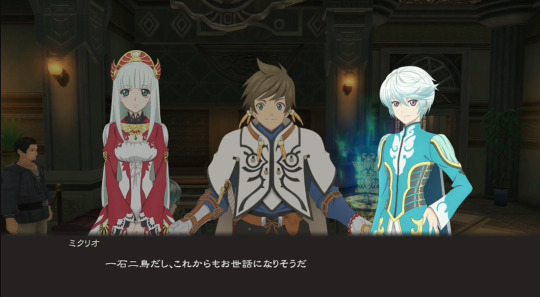

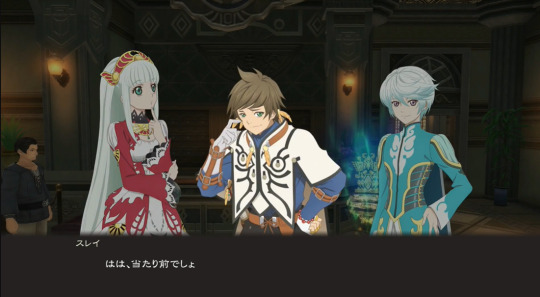


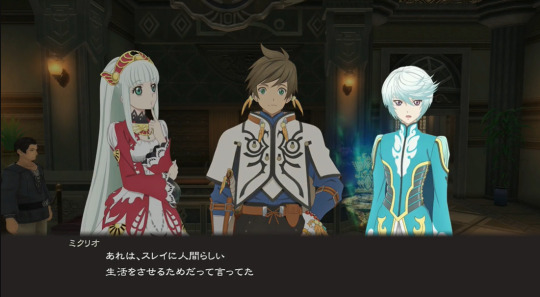
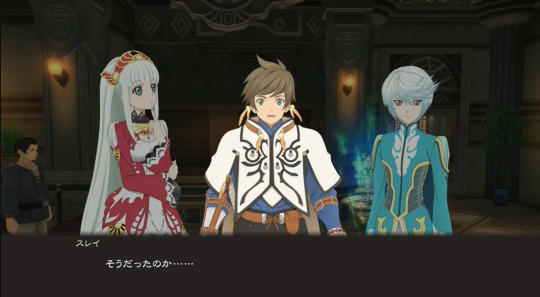
スレイ「なかなか美味いよな!宿屋の料理 」 ミクリオ「ああ。料理店を兼ねているのはいいな」 ミクリオ「一石二鳥だし、これからもお世話になりそうだ」 ライラ「ミクリオさんは、食事をなさるのですね?」 スレイ「はは、当たり前でしょ」 ミクリオ「いや。天族は食事をとる必要はない」 スレイ「ええっ!?ジイジたちもみんな食べてたじゃないか」 ミクリオ「あれは、スレイに人間らしい生活をさせるためだって言ってた」 スレイ「そうだったのか……」
SOREY: Oh, man, this is the best food I’ve had in ages! MIKLEO: Yeah. A quality inn and a quality restaurant, all in one. MIKLEO: Smart combination there. I have a feeling we’re going to be regular customers. LAILAH: Mikleo, do you eat? SOREY: Hah! Sometimes he even breathes! MIKLEO: What she means is, seraphim don’t actually have to eat to survive. SOREY: What?! But you, Gramps, everyone back in Elysia ate food all the time... MIKLEO: Gramps said that it was because we wanted you to experience life like a human. SOREY: Oh... I... I didn’t know...
As much as he is the child of miracles, one who always goes against all odds, in the world of Zestiria, everything has a reason behind it, even if that reason might be beyond what humans could understand. In this case, I want to believe that those miracles are because Sorey has his family and friends, in Elysia, in elsewhere. I’m so glad he was able to grow healthily to be a kind person despite his poor birth circumstances, but more than anything, that he was surrounded by such loving family and friends. Sorey is truly blessed, even centuries into the future.


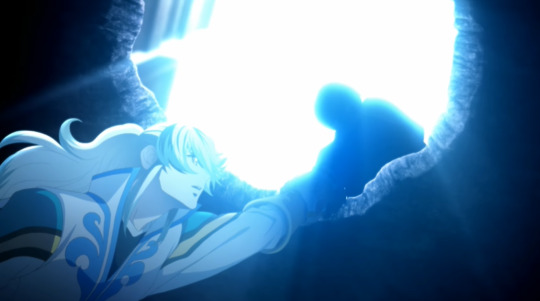


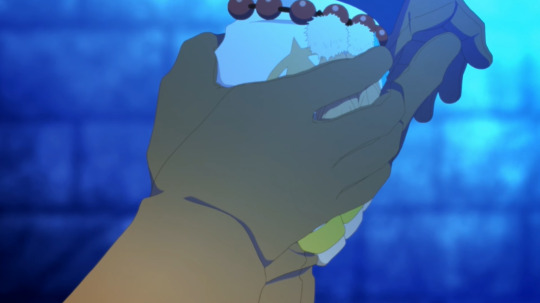
馬場 そしてミクリオが違う姿で登場し、冒頭のシチュエーションと同じようにガクっといくときに、手をふっと差し伸べるあのシルエットがね。
長谷 あそこに至るまでおそらく数百年は経っていますからね。
馬場 スレイがあそこまで冒険して、決断して、眠りについてまた出会うという流れは、ミクリオがあってこそだと思うので。
長谷 人間と天族の共存を象徴するのがあの2人の絆なので、どういう決着にするかはいろんなアイデアが出ましたね。
BABA: And then Mikleo appears, looking different, and just like the situation at the beginning of the game, when he falls down, there is that silhouette of that person holding out his hand.
HASE: It probably takes a several hundred years to get there.
BABA: I think Mikleo is exactly the reason why Sorey could get there; could go on such an adventure, make his decision, go to sleep, and then meet him again.
HASE: Since the bond between the two symbolizes the coexistence of humans and seraphim, there were many ideas on how to put a conclusion to their story.
#tales of#tales of zestiria#mino rambles#VERY VERY LONG POST with lots of pics like usual lol#this is now my srmk lovemail#please don't mind me#behind every great human is their seraph partner lmao#mino talks zesty
31 notes
·
View notes